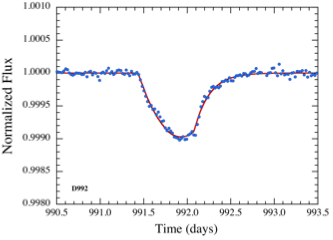Very neat paper recently published about the possible discovery of comets orbiting a distant star found using data from the Kepler mission.
To find the elusive exocomets, a group led by Prof. Saul Rappaport at MIT conducted an exhaustive search of more than 200,000 lightcurves collected by Kepler over its 3.5 year nominal mission.
By meticulously sifting these lightcurves by hand, Rappaport’s group were able to spot strangely and non-periodic signals, the kinds of signals that computers, with their rigid predictability, have trouble finding.

The shadow of an exocomet.
The figure at left shows the shadows of exocomets orbiting a very bright star, a little bigger than the Sun, as they pass between the star and the Earth. The cometary signal is asymmetric and doesn’t occur on a regular schedule, totally unlike an exoplanetary transit.
Rappaport’s group reports seeing six of these strange signals coming from the Kepler target star. Probably most of the signal is coming from a cloud of dust ejected by the exocomet. Such dust ejections are common for comets in our solar system, giving rise to one of the two lustrous tails usually seen for comets (the other tail is made of a stream of ionized plasma).
By fitting a simple dust model to the shadow signals, Rappaport and colleagues estimate that their exocomet is shedding dust at a rate of about 20,000 tons per second, roughly equivalent to the total mass of meteors that burn up in the Earth’s atmosphere every year.
The shadow signals appear six times, separated by tens to hundreds of days. Assuming the two dips separated by about 200 days are due to one comet (they don’t have to be), the comet would have to contain about as much mass as Halley’s comet and probably more.